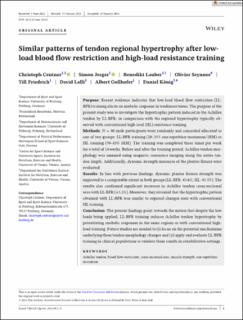| dc.contributor.author | Centner, Christoph | |
| dc.contributor.author | Jerger, Simon | |
| dc.contributor.author | Lauber, Benedikt | |
| dc.contributor.author | Seynnes, Olivier R. | |
| dc.contributor.author | Friedrich, Till | |
| dc.contributor.author | Lolli, David | |
| dc.contributor.author | Gollhofer, Albert | |
| dc.contributor.author | König, Daniel | |
| dc.date.accessioned | 2023-05-03T19:23:49Z | |
| dc.date.available | 2023-05-03T19:23:49Z | |
| dc.date.created | 2023-02-26T14:39:06Z | |
| dc.date.issued | 2023 | |
| dc.identifier.citation | Scandinavian Journal of Medicine & Science in Sports. 2023, Artikkel 14321. | en_US |
| dc.identifier.issn | 0905-7188 | |
| dc.identifier.uri | https://hdl.handle.net/11250/3066065 | |
| dc.description | This is an open access article under the terms of the Creative Commons Attribution License, which permits use, distribution and reproduction in any medium, provided the original work is properly cited. | en_US |
| dc.description.abstract | Purpose: Recent evidence indicates that low-load blood flow restriction (LL-BFR) training elicits an anabolic response in tendinous tissue. The purpose of the present study was to investigate the hypertrophic pattern induced in the Achilles tendon by LL-BFR, in comparison with the regional hypertrophy typically observed with conventional high-load (HL) resistance training.
Methods: N = 40 male participants were randomly and concealed allocated to one of two groups: LL-BFR training (20–35% one-repetition maximum/1RM) or HL training (70–85% 1RM). The training was completed three times per week for a total of 14 weeks. Before and after the training period, Achilles tendon morphology was assessed using magnetic resonance imaging along the entire tendon length. Additionally, dynamic strength measures of the plantar flexors were evaluated.
Results: In line with previous findings, dynamic plantar flexion strength was improved to a comparable extent in both groups (LL-BFR: 43.6%; HL: 43.5%). The results also confirmed significant increases in Achilles tendon cross-sectional area with LL-BFR (+5.2%). Moreover, they revealed that the hypertrophic pattern obtained with LL-BFR was similar to regional changes seen with conventional HL training.
Conclusion: The present findings point towards the notion that despite the low loads being applied, LL-BFR training induces Achilles tendon hypertrophy by potentiating anabolic responses in the same regions as with conventional high-load training. Future studies are needed to (i) focus on the potential mechanisms underlying these tendon morphology changes and (ii) apply and evaluate LL-BFR training in clinical populations to validate these results in rehabilitative settings. | en_US |
| dc.language.iso | eng | en_US |
| dc.subject | achilles tendon | en_US |
| dc.subject | blood flow restriction | en_US |
| dc.subject | cross-sectional area | en_US |
| dc.subject | muscle strength | en_US |
| dc.subject | one-repetition maximum | en_US |
| dc.title | Similar patterns of tendon regional hypertrophy after low-load blood flow restriction and high-load resistance training | en_US |
| dc.type | Peer reviewed | en_US |
| dc.type | Journal article | en_US |
| dc.description.version | publishedVersion | en_US |
| dc.rights.holder | © 2023 The Authors | en_US |
| dc.source.pagenumber | 9 | en_US |
| dc.source.journal | Scandinavian Journal of Medicine & Science in Sports | en_US |
| dc.identifier.doi | 10.1111/sms.14321 | |
| dc.identifier.cristin | 2129335 | |
| dc.description.localcode | Institutt for fysisk prestasjonsevne / Department of Physical Performance | en_US |
| dc.source.articlenumber | 14321 | en_US |
| cristin.ispublished | true | |
| cristin.fulltext | original | |
| cristin.qualitycode | 2 | |
